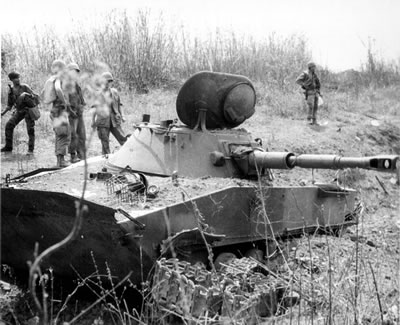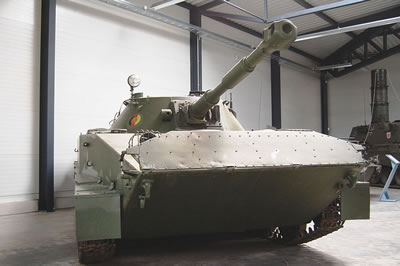
Last updated on February 19th, 2019 at 08:51 pm
The PT-76 light amphibious tank is a fully amphibious tank that was developed in the Soviet Union after the World War II. It has been used by countries all over the world.
During the Vietnam War, the North Vietnamese Army (NVA) used the PT-76. It could easily travel through rice paddies and traverse bridges that were not sturdy enough for heavier tanks.
The PT-76 was involved in the only tank vs. tank battle between the NVA and the US Army during the Vietnam War – the Battle of Ben Het in 1969, when 10 North Vietnamese PT-76 light amphibious tanks faced several American M48 Patton tanks.
Development
Long before World War II began, the Soviets had been building amphibious tanks.

In 1930, the Soviets purchased some British Carden-Lloyd light amphibious tanks and used the design as the basis for their own series of amphibious tanks.
Two prototype amphibious tanks, the T-33 and T-41 were built, but these were not accepted for mass production.
The first Soviet amphibious tank to be accepted for service was the T-37. It entered service in 1933.
In 1936, the T-37 tank was replaced by the T-38 amphibious tank.
During World War II, dealing with anti-tank weapons became an issue. When previous amphibious tanks had been designed, the focus was on keeping the tanks light so that they could float. As the war progressed, the Soviets realized that they had to make tanks that could resist fire from anti-tank weapons.
 The Soviets built a new amphibious tank, the T-40, with a hull and chassis that were less vulnerable to anti-tank weapons. The T-40 entered service in 1941 and remained in service until 1946.
The Soviets built a new amphibious tank, the T-40, with a hull and chassis that were less vulnerable to anti-tank weapons. The T-40 entered service in 1941 and remained in service until 1946.
In 1950, the Soviets began production of the PT-76, a fully amphibious tank that was designed to be used for reconnaissance, for crossing water obstacles during an attack and for supporting artillery when a beachhead was being established.
The PT-76 light amphibious tank entered service in 1952.
A Fully Amphibious Tank
The PT-76 is a fully amphibious tank. It can travel through water without special preparation.
Before the tank enters the water, a trim vane is erected in front of the tank. The driver’s center periscope is raised so he can see over the trim vane.
Bilge pumps are turned on so that the tank will remain afloat if it is hit.
The PT-76 was the first amphibious tank to use a hydrojet propulsion system to move it through water.
The tank has two water jets, one on each side of the hull. Their exits are in the rear of the tank. Water is drawn up into vents in the tanks belly, pressurized, and then expelled through the vents in the rear of the tank.
When the PT-76 is in water, the driver steers the tank in water by opening and closing covers over the vents.
An all-welded, flat, boat-shaped hull enables the PT-76 to move easily through water.
Specifications
The PT-76 light amphibious tank weighs 14 tons (14,600 kg) and has armor with a maximum thickness off 0.55 inches (14mm).
It uses a torsion bar suspension with six road wheels. There are no track return rollers. The idler is at the front and the drive sprocket is at the rear.
On land, the maximum speed of the PT-76 is 27 miles per hour (44 kph). On water, the PT-76 has a maximum speed is 6 miles per hour (9kph).
Maximum range on land is 230 miles (370km). Auxiliary fuel tanks containing 180 liters of fuel can be installed on the rear decking of the tank, increasing the range to 298 miles (480km).
A crew of three – a driver, a commander and a gunner/loader – operates – the PT-76 light amphibious tank.
The driver sits in the front of the hull, and the commander and the gunner/loader sit in the turret.
The engine and the transmission are in the rear of the hull
Armament on the PT-76 consists of a 0.3 inch (7.62mm) main gun and a 0.3 inch (7.62mm) coaxial machine gun.
The chassis of the PT-76 has been used as the basis for many other vehicles, including the BTR-50 armored personnel carrier, the ZSU-23-4 self-propelled anti-aircraft gun and the SA-6 Gainful anti-aircraft missile system.
Use
The PT-76 light amphibious tank has been exported to many different countries. Although production ended in the late 1960s, the tank is still in service in various countries around the world, including Russia, Vietnam, Afghanistan and North Korea.
A modified version of the PT-76 was built in China and was called the Type 60. The prototype of the Type 60 had many design flaws. The Chinese redesigned the tank and renamed it the Type 63
The Type 63 has a new turret, a 3.35 inch (85mm) main gun and an additional 0.5 inch (12.7mm) anti-aircraft gun. It entered service in 1963.
Some Type 63s were used by the North Vietnamese Army during the Vietnam w#ar.
The PT-76 has been used in many other conflicts, as well.
It was used by India during the 1965 and 1971 wars between India and Pakistan and by Egypt during the 1967 Six Day War and the 1973 Yom Kippur War.
Russia used the PT-76 during the 1999 invasion of Chechnya, and Iraq used it during the 1990/1991 and the 2003 Persian Gulf Wars.
PT-76 Light Amphibious |
|
|---|---|
| Active: | 1952 |
| Crew: | 3 |
| Weight: | 14.6 tons (14,600kg) |
| Length: | 22ft 8in (6.91m) |
| Height: | 7ft 4in (2.3m) |
| Width: | 10ft 4in (3.2m) |
| Weapons: | Main – 0.3in (7.62mm) gun, Secondary – 0.3 in (7.62mm) coaxial machinegun |
| Armor | Maximum – 0.55in (14mm) |
| Engine: | Model V-6B 6-cylinder water-cooled diesel, 240hp |
| Speed: | Land: 27mph (44kph), Water: 6mph (9kph) |
| Range: | 230 miles (370km) on land, can be increased to 298 miles (480km) with the addition of auxiliary fuel tanks |
